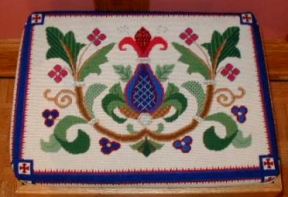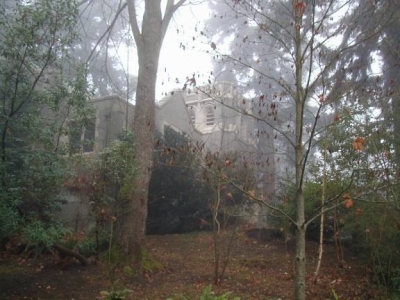|
St. Dunstan's Church of
the Highlands Parish
Shoreline, Washington
By Robert R. Chapman, Jr.
with assistance from Fr. Thomas Dement
With
a rich heritage, wonderful works of art, and a building
set in the natural beauty of its wooded surroundings,
St. Dunstan’s Church of the Highlands Parish in
Shoreline, Washington, understands the signification of
“worship the Lord in the beauty of holiness”.
St.
Dunstan’s parishioners began worshipping in the Florence
Henry Memorial Chapel around 1950. The Chapel, which
opened in 1911, is in The Highlands, a gated community
north of Seattle. W. Marberry Somervell – well known
locally for his design of the Green Lake and Roosevelt
library branches in Seattle – designed the Florence
Henry Memorial Chapel. While there are arrangements with
the Diocese of Olympia for St. Dunstan's to use the
Chapel, the building is owned by the Highlands and has
never been consecrated as an Episcopal church.
| |
 |
| |
Bas-relief of the Last Supper
over the altar in the Henry Chapel. |
| |
|
| |
 |
| |
The "west window" in the Henry
Chapel. |
| |
|
The Chapel has a marble
bas-relief of the Last Supper that was carved for the
Italian exhibit of the 1909 Alaska-Yukon-Pacific
Exposition. Horace and Susan Henry, donors of the
Chapel, purchased the carving when the Exhibition closed
and had it installed over the altar in a specially
carved wood frame.
There
are three tuned bells in the tower. While not hung for
change ringing, this ringing style can be approximated
with some effort. The windows in the nave and sanctuary
are stained glass in a late medieval period (14th
century) style. The Charles Connick Studio of Boston
created and installed them from 1932 to 1960. There is
also a carved rood screen separating the choir from the
nave. This adds to the feeling of tradition when
worshipping in the Chapel.
The new
congregation, not owning the Henry Chapel, purchased
land near the Highlands for a parish hall. What was
originally built as the parish hall has now become the
primary place for worship. Services are still held in
the Chapel for the early Sunday morning Eucharist and
the late evening Eucharist on Christmas Eve.
Through
the years, St. Dunstan’s has grown gracefully into a
beautiful place to worship God. Much of that grace is
the artwork on the grounds, including a carving of Chief Spokan Garry holding a Book of Common Prayer on his lap
while offering a sign of peace.
Artist
Dudley C. Carter (1891-1992) created the carving of
Chief Spokan Garry (?-1892) from a dead tree on a wooded
portion of the property in 1961. The work followed the
publication in 1960 of Chief Spokan Garry (T. S. Denison
& Company, Inc., Minneapolis) by the Rev. Canon Thomas
E. Jesset, who was then vicar of St. Dunstan’s. There
are numerous works by Carter in the metropolitan Seattle
area and San Francisco.
| |
 |
|
 |
| |
"Spokan Garry," carved by Dudley
C. Carter. |
|
Celtic cross designed by Lycia
Danielle Trounton before mounting over porch. |
Chief Spokan Garry learned
about Christianity and Anglicanism when he was sent to
the Red River School, Fort Garry (Winnipeg), Manitoba.
The chief – whose tribe held the lands where Spokane,
Washington, stands today – was instrumental in
negotiating peace treaties with the territory of
Washington and the United States government.
A
Celtic cross designed by Lycia Danielle Trounton was
placed over the porch at the main church entrance in
2003. It has Celtic knot-work intertwined with symbolism
related to the most famous of the Glastonbury abbots and
parish patron, Dunstan. The cross was a commission by
two parishioners, Tom and Jean Keefer, to commemorate
the tragic loss of a daughter and son.
Many
Episcopal churches have needlework kneelers at the
communion rail as does St. Dunstan’s. The original 10
kneelers were presented in 1994. Additional kneelers
were added later to accommodate a redesigned sanctuary.
The design on each of the primary kneelers includes
different designs of a cross (Bottony, Celtic, Fitchee,
Greek, and so forth).
| |
 |
| |
Seat cushion
created by Jeanette Michel. |
| |
|
| |
 |
| |
Tiles
created by St. Dunstan's
parishioners and mounted along the stairway to
the undercroft. |
| |
|
In addition to the kneelers,
there are two seat cushions in the sanctuary designed
and created by Jeanette Michel. Based on traditional
religious designs, these cushions complement the festive
altar frontal. At the center of the design is a bursting
pomegranate, a symbol of the Resurrection and the power
of Jesus – who burst the tomb and come forth again in
life. The pomegranate also serves as a symbol of the
church – one fruit containing many seeds.
A
recent project involved a large cross-section of St.
Dunstan’s Parish when individuals and families were
invited to paint a tile with some identifying symbol.
Afterwards, these tiles were fired and mounted along the
stairway to the undercroft.
The
church school has taken this idea a step further (no pun
intended) by having students create small concrete
octagons and circles into which they have left objects
and traced words. Upon completion, these were placed
along the various walkways and paths on the property.
St.
Dunstan’s building fits beautifully on a large wooded
lot. The windows in the nave allow the outside beauty to
surround worshipers. Plantings in the garden areas blend
with otherwise natural surroundings. An outdoor
columbarium nestles among trees and rhododendrons.
Instead of a labyrinth, St. Dunstan’s offers wooded
trails for meditative walking.
There
are different types of the beauty of holiness. The
Florence Henry Memorial Chapel speaks of a deep
traditional artistic glory. St. Dunstan’s Church has
carefully added human works among a natural glory. The
parishioners of St. Dunstan’s Church of the Highlands
Parish receive nurture from both.

The Florence Henry Memorial Chapel
St. Dunstan’s Church of
the Highlands Parish
722 N 145th St
Shoreline, Washington 98133
(206) 363-4319
website:
www.st-dunstans-episcopal.us
Story in a printable PDF format |
![]()